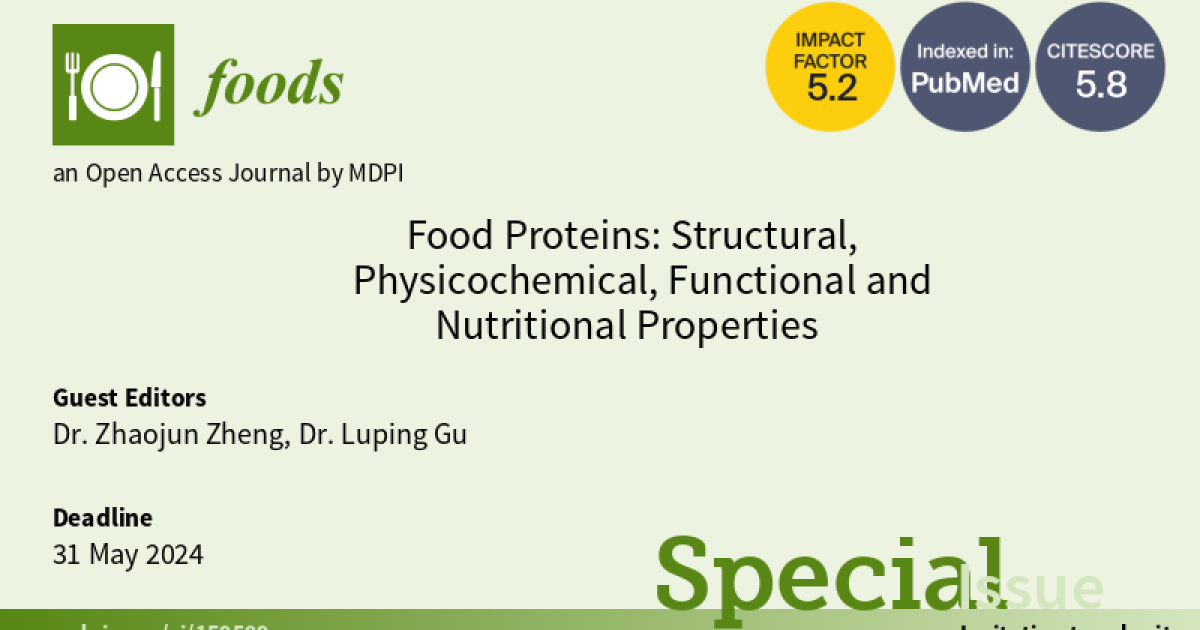Food Proteins: Structural, Physicochemical, Functional and Nutritional Properties
A special issue of Foods (ISSN 2304-8158). This special issue belongs to the section "Food Physics and (Bio)Chemistry".
Deadline for manuscript submissions: closed (31 May 2024) | Viewed by 10998

Special Issue Editors
Interests: food proteins and peptides; bioactive compounds; antioxidants; protein modification; functional and structural properties
Special Issue Information
Dear Colleagues,
Food proteins are essential macronutrients for human health, and thus, make significant contributions to the unique functions of different foods. The nutritional and functional properties of food protein ingredients depend on their source, extraction, modification during food manufacture and interactions with other food components. Physical, chemical and biological treatments for the modification of proteins are considered as being among the major emerging and promising technologies for improving the functional and nutritional properties of food products. However, protein modification is a complex task, which produces extensive effects on the digestibility, nutritional compositions and conformational structures of proteins. Recent advances that refer to the specific changes occurring within proteins are currently under study. Therefore, we are highly interested in and encourage manuscripts related to the efficient and innovative modification methods on protein structures and physicochemical properties, the exploitation of proteins with functional and nutritional properties, the structural–functional relationship, as well as the exploration of protein resources.
Dr. Zhaojun Zheng
Dr. Luping Gu
Guest Editors
Manuscript Submission Information
Manuscripts should be submitted online at www.mdpi.com by registering and logging in to this website. Once you are registered, click here to go to the submission form. Manuscripts can be submitted until the deadline. All submissions that pass pre-check are peer-reviewed. Accepted papers will be published continuously in the journal (as soon as accepted) and will be listed together on the special issue website. Research articles, review articles as well as short communications are invited. For planned papers, a title and short abstract (about 100 words) can be sent to the Editorial Office for announcement on this website.
Submitted manuscripts should not have been published previously, nor be under consideration for publication elsewhere (except conference proceedings papers). All manuscripts are thoroughly refereed through a single-blind peer-review process. A guide for authors and other relevant information for submission of manuscripts is available on the Instructions for Authors page. Foods is an international peer-reviewed open access semimonthly journal published by MDPI.
Please visit the Instructions for Authors page before submitting a manuscript. The Article Processing Charge (APC) for publication in this open access journal is 2900 CHF (Swiss Francs). Submitted papers should be well formatted and use good English. Authors may use MDPI's English editing service prior to publication or during author revisions.
Keywords
- food proteins
- structure
- physicochemical properties
- functionality
- nutritional properties
- food processing
- protein modification
- digestive profile
Benefits of Publishing in a Special Issue
- Ease of navigation: Grouping papers by topic helps scholars navigate broad scope journals more efficiently.
- Greater discoverability: Special Issues support the reach and impact of scientific research. Articles in Special Issues are more discoverable and cited more frequently.
- Expansion of research network: Special Issues facilitate connections among authors, fostering scientific collaborations.
- External promotion: Articles in Special Issues are often promoted through the journal's social media, increasing their visibility.
- e-Book format: Special Issues with more than 10 articles can be published as dedicated e-books, ensuring wide and rapid dissemination.
Further information on MDPI's Special Issue polices can be found here.







